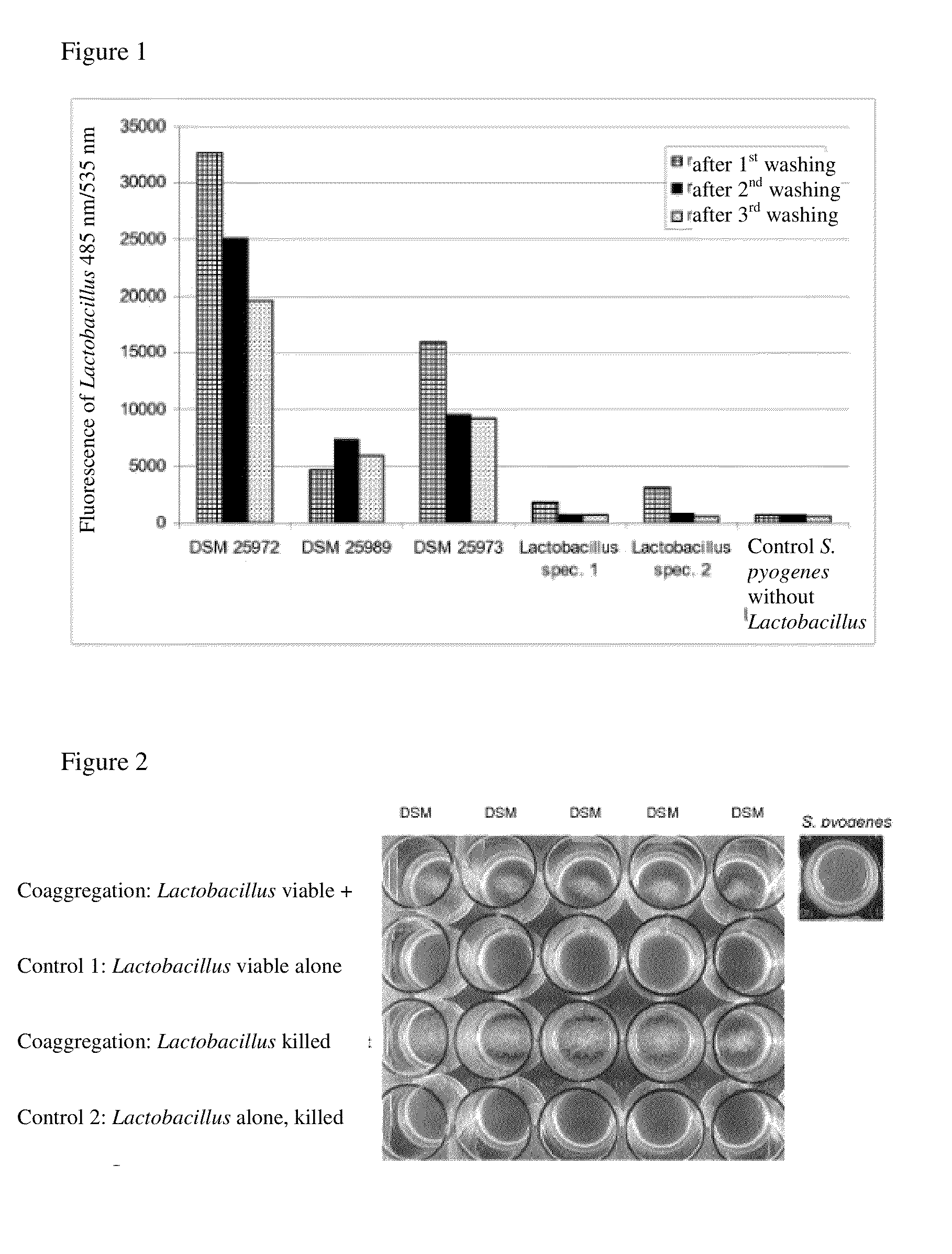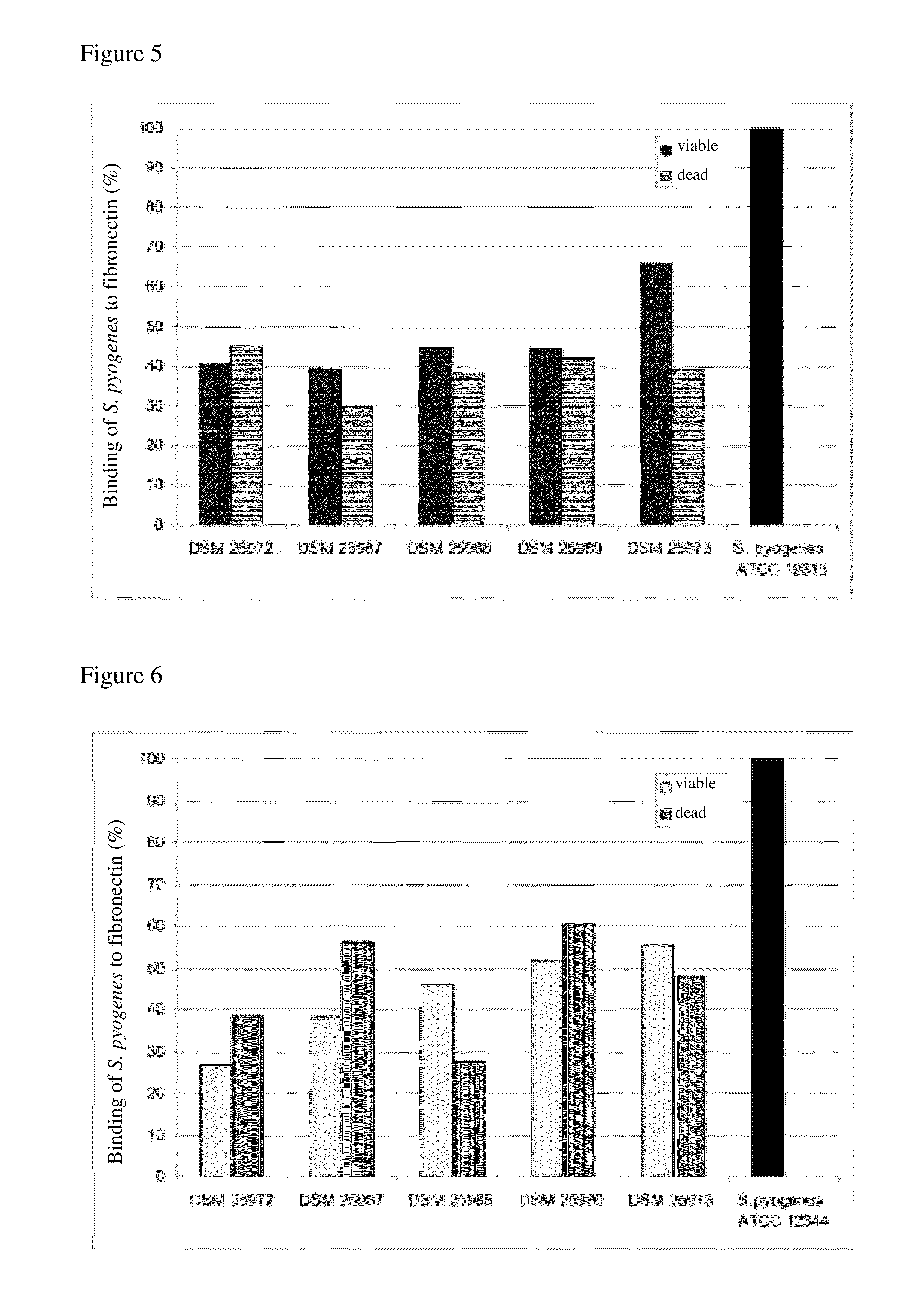Novel lactic acid bacteria and compositions containing them against bacterial colds
a technology which is applied in the direction of biocide, plant growth regulators, animal feeding stuff, etc., can solve the problems of no prevention, no functioning vaccine has been developed, and most infections subside, so as to improve the distribution of lactic acid bacteria and compositions, reduce the viscosity, and improve the effect of rheological properties
- Summary
- Abstract
- Description
- Claims
- Application Information
AI Technical Summary
Benefits of technology
Problems solved by technology
Method used
Image
Examples
example 1
[0123]For identification and selection of microorganisms according to the invention, various strains from a Lactobacillus strain bank were tested by a four-step screening process in which they were first screened with regard to the ability to bind to the target pathogenic microorganism Streptococcus pyogenes (hereinafter also referred to as the “target microorganism”) (binding assay) and then the strains identified in the first step were tested in a coaggregation assay in the microtiter plate scale, where the coaggregation with the respective target microorganism was measured qualitatively using a binocular stereo microscope. In the sense of the present invention, the term “co-aggregation” is used as synonymous with the term “coaggregation.” Furthermore, the intensity of coaggregation and the stability of the binding to the target microorganism as well as the ability to prevent binding to fibronectin were investigated, ultimately leading to the exemplary microorganisms according to ...
example 2
Coaggregation Assay
[0129]The following verification in a 1.0 mL volume and / or in a 24-well plate is used to illustrate the coaggregation activity of selected Lactobacillus strains.
[0130]In this method, the coaggregation behavior of the lactobacilli and of the target strain is considered separately and finally the coaggregation of Lactobacillus and the target strain together in a mixture is considered. This analysis is performed macroscopically by using photographs of the 24-well plate as well as microscopically. To perform these tests, the target microorganism, Streptococcus pyogenes, was cultured according to standard protocols. The strain was cultured in THY (Todd Hewitt broth) medium under aerobic conditions, in 5% CO2 atmosphere at 37° C. The Lactobacillus strains were cultured in MRS medium (see de Man et al. (1960) “A medium for the cultivation of lactobacilli,” J. Appl. Bact. 23 (130-135)) anaerobically at 37° C. For workup of the target microorganism, the cells were harveste...
example 3
Coaqgregation in Human Saliva
[0132]To investigate the coaggregation capability of the Lactobacillus strains according to the invention in natural human saliva, they were harvested after 16 hours of culturing as described in Example 2, washed twice in PBS and placed in human saliva. The saliva had previously been collected from several people, mixed and separated from the particles by centrifugation at 8000 g at 20 minutes. The target microorganism was worked up as described in Example 2 and was likewise placed in human saliva after washing twice in PBS. To perform the coaggregation assay, 500 μL portions of the target microorganism suspension in saliva were combined with 500 μL Lactobacillus suspension in saliva per well in a 24-well plate. Control batches with 500 μL of the target microorganism plus 500 μL saliva or 500 μL of the respective Lactobacillus suspension plus 500 μL saliva (control 1) were carried in parallel. After incubating for 10 minutes at 25° C. on a desktop agitat...
PUM
| Property | Measurement | Unit |
|---|---|---|
| Acidity | aaaaa | aaaaa |
| Biological properties | aaaaa | aaaaa |
| Optical density | aaaaa | aaaaa |
Abstract
Description
Claims
Application Information
 Login to View More
Login to View More - R&D
- Intellectual Property
- Life Sciences
- Materials
- Tech Scout
- Unparalleled Data Quality
- Higher Quality Content
- 60% Fewer Hallucinations
Browse by: Latest US Patents, China's latest patents, Technical Efficacy Thesaurus, Application Domain, Technology Topic, Popular Technical Reports.
© 2025 PatSnap. All rights reserved.Legal|Privacy policy|Modern Slavery Act Transparency Statement|Sitemap|About US| Contact US: help@patsnap.com



